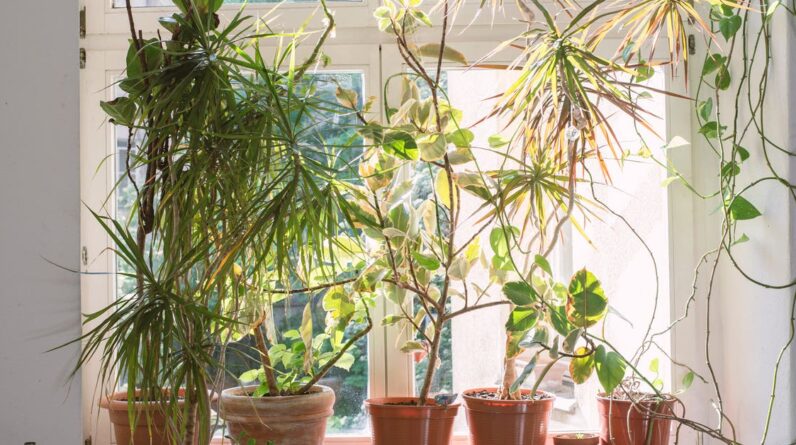
National Houseplant Appreciation Day celebrates the beauty and benefits of indoor plants, creating awareness of their positive impact on our physical and mental well-being. Having houseplants in your space not only enhances the aesthetic appeal but also purifies the air, reduces stress, and increases productivity.
This special day encourages people to embrace the joys of houseplant ownership and promote healthy living through greenery. So, whether you are an experienced plant enthusiast or a beginner, take this opportunity to show gratitude for your leafy companions and foster a deeper connection with nature.
Benefits Of Indoor Greens
Improved air quality: Having indoor greens can significantly improve the air quality in your home or office space. Plants naturally release oxygen and absorb carbon dioxide, helping to cleanse the air of toxins and pollutants. Greenery can also remove common volatile organic compounds (VOCs), such as formaldehyde and benzene, which are found in everyday items like cleaning products and furniture.
Reduction of stress and anxiety: It has been proven that being surrounded by plants can reduce stress levels and promote a sense of calmness. The presence of greenery can help to lower blood pressure and heart rate, improving overall well-being. Studies have shown that even just the view of plants can have a positive impact on mental health and stress reduction.
Boost in productivity: Indoor greens can also enhance productivity and focus. Being in close proximity to plants has been found to increase attentiveness and improve task performance. Plants have a soothing effect on the mind, helping to improve concentration and reduce distractions. Increased productivity can lead to a more efficient and successful work environment.

Credit: www.wildinteriors.com
Choosing The Right Houseplants
When choosing houseplants for your home, it’s important to consider the lighting conditions in each room. Different plants have different light requirements, so it’s crucial to match their needs to the available natural light in your space. Some plants thrive in bright, direct sunlight, while others prefer indirect or low light conditions. Assessing the lighting conditions in your home will help you determine which plants are the best fit.
Space availability is another factor to consider when selecting houseplants. Take a look at the size and layout of each room to determine how much space you have available for plants. Some plants can grow quite large, while others are more compact and suited for smaller spaces. It’s important to choose plants that fit your available space without overcrowding.
Researching the care requirements of potential houseplants is essential for their long-term health. Some plants are low-maintenance and can tolerate neglect, while others require more consistent care. Understanding their watering, fertilizing, and temperature needs will help you provide the appropriate care for your plants, ensuring they thrive in your home.
Creating The Ideal Indoor Environment
Providing adequate light: Houseplants require varying levels of light, so it’s essential to find the right spot for each plant. Place plants near a window to ensure they receive enough sunlight, but be careful not to expose them to direct sunlight for prolonged periods, as it can scorch the leaves. If your living space doesn’t receive much natural light, consider using artificial grow lights to provide the necessary light for your houseplants.
Maintaining optimal temperature and humidity levels: Different plants have different temperature and humidity requirements, so it’s important to familiarize yourself with the specific needs of your houseplants. Most houseplants thrive in temperatures between 65-75°F (18-24°C). Keep them away from drafts, as sudden temperature fluctuations can harm the plants. Maintaining proper humidity levels is also important. You can use a humidifier or place your plants on a tray filled with water and pebbles to increase humidity around them.
Proper watering techniques: Overwatering or underwatering can both be detrimental to houseplants. It’s crucial to water your plants only when the top inch of soil is dry. Use a watering can with a narrow spout to target the soil directly and avoid getting water on the leaves. Ensure proper drainage to prevent waterlogged roots. Remember that different plants have different water requirements, so it’s essential to understand the specific watering needs of each houseplant in your collection.
Essential Tips For Plant Care
One of the most important aspects of plant care is understanding the watering schedules. It is essential to ensure that plants are neither under-watered nor over-watered. Different plants have different water requirements, so it’s important to research and understand the specific needs of each plant. Factors such as the type of plant, the season, and the climate can affect the watering schedule. Monitoring the moisture level of the soil is crucial to determine when to water. It is better to water plants in the morning to allow adequate time for the foliage to dry out, reducing the risk of diseases.
Fertilizing plants properly is another vital aspect of plant care. Fertilizers provide essential nutrients that plants need to thrive. It is important to choose the right type of fertilizer for specific plants and follow the recommended dosage. Over-fertilizing can be harmful and lead to burnt roots or stunted growth. It is best to fertilize plants during their active growing season to support healthy growth and blooming.
Pruning and grooming plants regularly help maintain their shape, promote growth, and prevent diseases. Removing dead or diseased leaves, stems, and flowers stimulates new growth and improves the overall appearance of the plant. Use clean and sharp pruning tools to avoid damaging the plant. Understanding the specific pruning requirements of each plant is crucial as different plants have different pruning needs.
Preventing Common Houseplant Problems
The key to preventing common problems with houseplants is proper identification and treatment of pests, addressing root rot and overwatering, and handling yellowing leaves.
Pests:
Pests can quickly infest your houseplants, damaging their health and appearance. Some common plant pests include aphids, mealybugs, spider mites, and scale insects. To identify pests, <
Root Rot And Overwatering:
Root rot occurs when the roots are constantly submerged in water, leading to decay and eventually the death of the plant. Avoid overwatering by allowing the top inch of the soil to dry before watering again. Ensure proper drainage by placing pebbles or gravel at the bottom of the pot. If root rot has already occurred, carefully remove the affected parts and repot the plant in fresh soil and a well-draining container.
Yellowing Leaves:
Yellowing leaves can be a sign of various issues, including overwatering, nutrient deficiencies, or pest infestations. To address yellowing leaves, analyze the underlying cause and take appropriate action. Adjust your watering schedule, provide adequate sunlight, and use balanced plant fertilizers. If pests are present, follow the previously mentioned steps to treat them effectively.
Incorporating Houseplants Into Home Decor
When incorporating houseplants into your home decor, it is essential to choose suitable pots and planters. The right selection not only enhances the aesthetic appeal of your space but also contributes to the overall health and growth of your plants. Opt for pots with drainage holes to prevent over-watering and consider the material, size, and color that complement your interior style. Styling plants in different rooms allows you to create a cohesive and balanced ambiance throughout your home. In the living room, consider large leafy plants for a bold statement, while smaller plants can add a touch of greenery to your bedroom or office. Additionally, creating themed plant arrangements can add a unique touch to your decor. Experiment with combining different plants or sticking to a particular color palette to tie everything together.
Propagation And Expansion Of Houseplant Collection
- A popular method for propagating houseplants is leaf or stem cuttings. Simply take a leaf or stem cutting from a healthy plant, dip it in rooting hormone, and place it in a pot with moist soil.
- Division is another effective technique. Carefully take out the plant from its pot and gently separate the roots into multiple sections. Replant each section into its own pot with fresh soil.
- Air layering is a more advanced technique but can be rewarding. Make a small cut in a stem, wrap it with moist sphagnum moss, and cover it with plastic wrap. Roots will start to form, and once they’re established, the new plant can be cut away from the parent.
- Adding new species is an exciting way to expand your houseplant collection. Research different types of plants that you’re interested in and consider their care requirements to ensure successful growth.
- Trading and sharing plants with other enthusiasts can help you diversify your collection without spending a lot of money. Participate in local plant swaps or join online communities where members exchange cuttings and plants.
Showcasing Houseplants On Social Media
National Houseplant Appreciation Day is an excellent opportunity to showcase your beloved plants on social media and connect with the thriving houseplant community online. One key aspect of capturing appealing plant photographs is to focus on their unique features and textures. A macro lens can help magnify the intricate details of leaves and blooms, creating visually stunning images. Another way to enhance the visibility of your plant photos is by incorporating relevant hashtags. These keywords can attract like-minded individuals who share a passion for indoor gardening and increase the chances of your posts being discovered. Furthermore, engaging with the houseplant community by liking, commenting, and sharing their content fosters a sense of belonging and encourages them to reciprocate. By actively participating in this thriving online community, you can gain inspiration, learn new care tips, and converse with fellow plant enthusiasts.
Frequently Asked Questions On National Houseplant Appreciation Day
What Is Plant Appreciation Day?
Plant Appreciation Day is a special day dedicated to recognizing and celebrating the importance of plants. It’s an opportunity to raise awareness about the benefits of plants to our environment and well-being. Take part by learning about different plants, planting trees, or simply spending time in nature.
What Is Houseplant Week?
Houseplant Week is a dedicated time to celebrate and appreciate houseplants. It aims to raise awareness about the benefits of having indoor plants and encourages people to connect with nature by incorporating these green beauties into their living spaces.
Why Do Millennials Love Houseplants?
Millennials love houseplants for their ability to bring nature indoors, enhance air quality, and add a touch of green to their living spaces. Houseplants also provide a sense of responsibility, improve mental well-being, and create a calming environment.
Is There An International Plant Day?
Yes, there is an International Plant Day. It is celebrated on May 18th every year worldwide.
Conclusion
Houseplants are more than just decorative elements; they are companions that bring joy and enhance our living spaces. National Houseplant Appreciation Day serves as a reminder to nurture and care for these green companions, providing us with cleaner air, reduced stress, and a sense of serenity.
Whether you’re a seasoned plant parent or just starting your indoor garden, take this opportunity to appreciate and honor the beauty of houseplants. Add some green to your life and let these botanical wonders bring nature closer to your doorstep.




